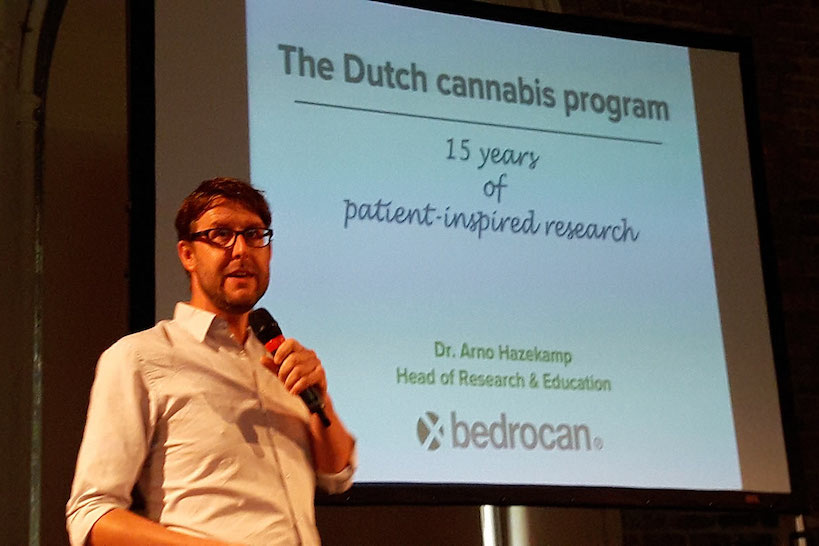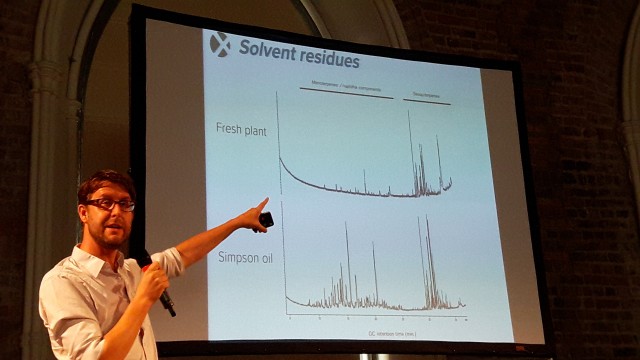At the Global Medical Cannabis Summit Dublin on September 14th 2016 international cannabis advocates, scientists and researchers came together under the roof of the Smock Alley Theatre on the north bank of the River Liffey. It is the first time an event of this magnitude has been hosted in the British Isles and hosts Help Not Harm and Volte Face along with Tilray, Leafly and Bedrocan helped set the scene for the impending discussions on global medical cannabis advancements.
Amongst the speakers and panelists was cannabis research veteran Arno Hazekamp who has been studying the plant and it’s over 460 constituent components across over 600 different strains of cannabis. He is the first to admit that it is no simple task and when you look at the detail, as he has, you can really understand why it might have taken so long to understand cannabis. Not least to take into consideration our collective understanding is evolving as the research is taking place so it is in all actuality an endless task. If variety is the spice of life.
“In 2001 there were no standards, I had to make my own” by this Arno Hazekamp head of research at Bedrocan the Netherlands Medical Cannabis producer means he had to strip down cannabis into each of its components and work up from there.
Standardization does not mean making all cannabis all the same, we know there are many different strains and varieties and this is why so many people get a different view or experience of cannabis around the world or even living next door to each other. What needs to be understood about standardization of cannabis is that its about consistency of production. Can you produce near enough (because nature has to have some forgivness) the same product every time. This can’t be told via looking and smelling it or even having a joint of it…no we need to analyse samples of each batch grown and produced under HPLC testing facilities. Not something many people have lying around let alone access too. Were something like this available in the community maybe people would be able to know what they are ingesting and inhaling cannabinoid wise and contamination wise.
Arno explained that because of the varietes of cannabis there are it sometimes turns out that something is missing in their catalogue of standardized grown products. To understand what it was that patients were looking for in modern medical cannabis varieties they conducted some patient market research. This included mapping out the 460 varieties of cannabis that Arno had tested on a grid that allowed him to see the similarities in strains and the variances. Interestingly hemp cultivars all land quite near the center of the grid meaning they are quite similar in composition. When the 6 Bedrocan products were placed on the grid it allowed them to see what areas of the wider cannabis genome they were missing from their product line. Looking at the statistics they noticed an area that they wanted to look more closely at which involved identifying the strains located in that grid region. To show you how accurate their system is the strain that came back was something similar to varieties of Amnesia Haze, the same strain name patients had been telling them they need to add to their catalogue.
Patient inspired research indeed!
For us at the UK Cannabis Social Clubs however, we could not watch Arno give his presentation about medical cannabis and not draw attention to the fact that these medical strains are actually very similar (as his grid shows) if not the same as cannabis strains that are commercially available in coffeeshops and those that are being consumed by many recreational and medicinal users illegally here in the UK, the only difference is they were not grown in the same room as every flower Bedrocan produce was – making it standardized.
Is Bedrocan safer than Skunk?
In the UK we have the problem of the media’s reefer madness skunk frenzy where once a month or there about we see a story about how skunk cannabis is 20x stronger than what they smoked in the 60’s, which is rubbish because, well, we’ve seen the footage of Woodstock. Skunk is a variety of cannabis that was first introduced as a seed you could grow indoors under artificial lighting bred by Sam Skunkman. Sam later went on to sell his genetic library to GW Pharmaceuticals who produce the UK’s poorly received Sativex cannabis mouthspray which is unnavailable to 90% of the MS patients it is designed to help because of its high price tag. The Government’s official line on cannabis is that because of skunk it is much more harmful, very very toxic and leads to serious mental health problems. Oddly that same skunk is being used in trials to treat schizophrenia and psychosis…
If that seems confusing to you that’s because it is, because it has no basis in science. The Home Office describe skunk as “cannabis grown under high intensity lighting, with high THC and with little or no CBD”, Yet if you look at Bedrocan’s flagship strain it clocks in at 19% THC less than 0.1% CBD and is grown under high intensity lighting. It shouldn’t take a genius to work out that either Bedrocan are flogging skunk as medical cannabis or the British Home Office are very confused about cannabis classification and brand names.
By it’s very nature, brand name or not, Skunk is a variety of Medical Cannabis, especially if you are following the Home Offices definition (except the part where they say “in herbal form” which again is unscientific because if it isn’t there in it’s herbal form, where the hell is it?”
Well, if Amnesia Haze is going to be a new medical strain that means 70% of the UK market are getting a medical strain of cannabis, because that’s one of the biggest cash cropping strains for commercial growers too. Soma, the breeder of Amnesia must be very happy that his strain is so popular with both the medical consumers and recreational consumers and is being considered by a pharmaceutical company. To us, that should give hope to those in the UK that even if something comes from illegal origins, it can still have a very high medicinal value. How wrong are our Government getting this?
We can all agree, with the evolution of good growing practices and techniques and the spreading of better genetics to get an assured end product, there is much more high quality cannabis available on the market, albeit illicit. Patients using it medicinally are consuming this home grown cannabis and finding it effective so it certainly has medical value and deserves a rescheduling away from Schedule 1 into 2 or 4.
Which oil making method is best?
Analyzing the subject of cannabis has thrown up its difficulties. From olive oil extractions to butane honey oil, Rick Simpson Oil and CO2 they all yield a different result even from the same standardized starting material. In the video Arno shows slides which detail the residual solvents left in some methods of extraction such as RSO using Naptha and comparing that to the original plants residual results. Some methods captured more terpenes, some more minor cannabinoids, but none was exclusively encompassing of an actual whole plant extract. If your really want Full Extract Cannabis Oil you are best to consume the raw bud as well as every method to extract…impossible, right!?
“You look for things that are supposed to be there and we have to look for things that shouldn’t be there, and you need to know how to do that with the sticky consistency of cannabis.”
The one method that was not looked at which is very new to the world of cannabis and has come straight out of the recreational community is Rosin Technique developed by Soilgrown Solventless. By using heat and pressure you an quash the raw plant material and extract the oil. We have reached out to Arno and offered our assistance in testing the standardized Bedrocan strains with this new extraction method to see how the analysis compares to the other trials that were conducted. We will let you know if that goes anywhere, as this is a very innovative way of extracting, it is cheap and safe to do without any chemicals or explosion risks and is likely to be taken up by may recreational and medical consumers in the next couple of years.
You can take a look at the analysis test sheets here and see what Arno is pointing to.
As with all research taking time, new things come to light just as quickly in other areas. Rest assured we will be learning more about cannabis for many more years to come.
Support your #Right2Grow, share and collectively consume cannabis while the MP’s and scientists try and figure it all out and take part in the growing revolution that is helping change the social situation for cannabis consumers and creating greater access to a safer quality of cannabis than if they were left to but on the streets. Find you local club here!





